MARIANI’S
Virtual
Gourmet
June
20, 2021
NEWSLETTER
ARCHIVE
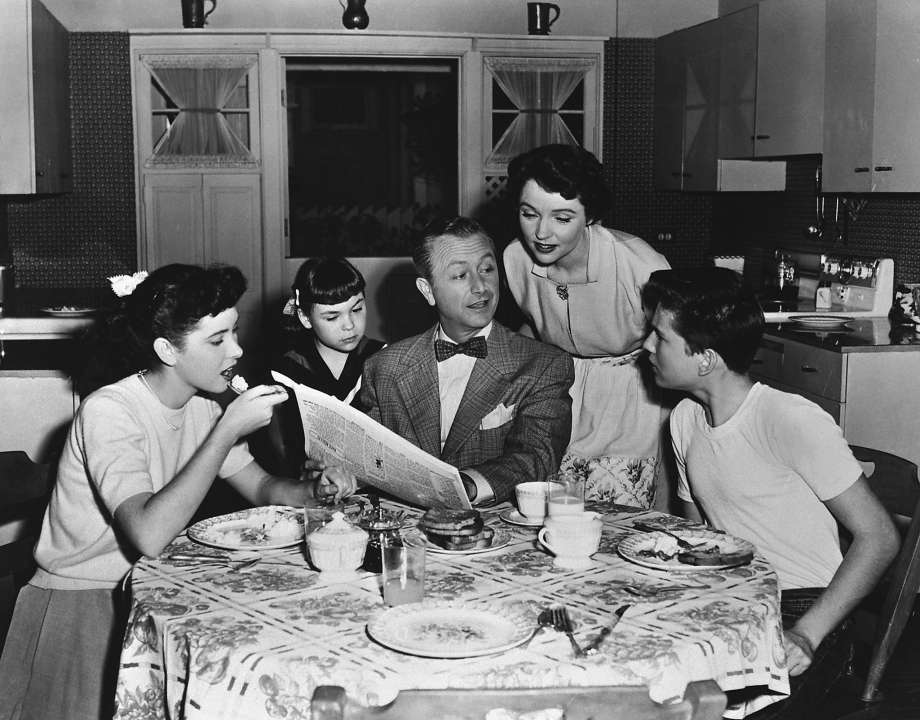
Elinor Donahue, Lauren Chapin, Robert Young, Jane Wyatt and Billy Gray in "Father Knows Best"
HAPPY FATHER'S DAY!
IN THIS ISSUE
WHAT YOU SHOULD KNOW BEFORE
CRITICIZING A RESTAURANT
IN THE POST-PANDEMIC ERA
By John Mariani
NEW YORK CORNER
PUTTANESCA
By John Mariani
CAPONE'S GOLD
CHAPTER TWELVE
By John Mariani
NOTES FROM THE WINE CELLAR
BARGAIN BOTTLES FROM PORTUGAL
By GEOFF KALISH
❖❖❖

❖❖❖
WHAT YOU SHOULD KNOW BEFORE
CRITICIZING A RESTAURANT
IN THE POST-PANDEMIC ERA
By John Mariani
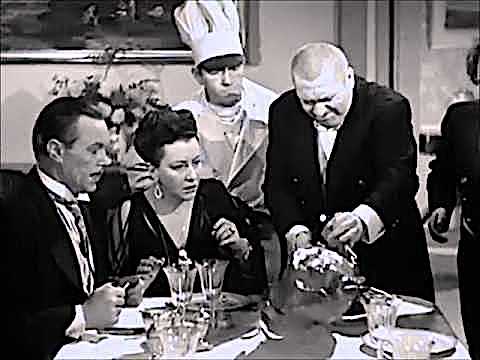
Nothing could
make me happier than to have been right last
year about how vibrantly the American restaurant
industry, from fast food to fine dining, would
rebound as the pandemic allows them to reopen at
100% capacity. These restaurateurs have
struggled mightily to stay afloat and their
staff to handle everything from child care to
meeting the rent.
There’s no question that the federal
assistance programs, which allowed businesses to
apply for up to $10 million through the American
Rescue Plan’s $2.8 billion Restaurant
Revitalization Fund, was critical in keeping the
industry from imploding, and the dire predictions
by some analysts about 70% of America’s
restaurants closing permanently proved to be
nonsense. Many have, but in any year a good
percentage of restaurants close for myriad reasons
that had nothing to do with Covid.
People are desperate to eat out and are
flocking to every kind of restaurant, from
taquerias to trattorias, from bistros to fine
dining, and scores of new restaurants are opening
every day across the country. New York
magazine just published a guide to 66 of the best
new restaurants in the city, and the Washington
Post had a similar article on the city’s
current bounty of restaurants.
That said, there are still some varying
health rules in place, and we are not yet back to
the old normal, if we ever do get there. So,
anyone who criticizes a restaurant for not being
quite what it used to be—yet—should cut it a good
deal of slack. Not long ago, I went to a favorite
steakhouse in New York to find its luxurious
dining room empty because they were only using an
upstairs outdoor section without anything close to
the downstairs ambiance. They also had an
abbreviated menu, took off items they could not
afford to waste and made do with a smaller,
not-so-skilled staff. Here, then, are some reasons
to expect the best they can provide right now even
it’s not yet quite up to snuff:
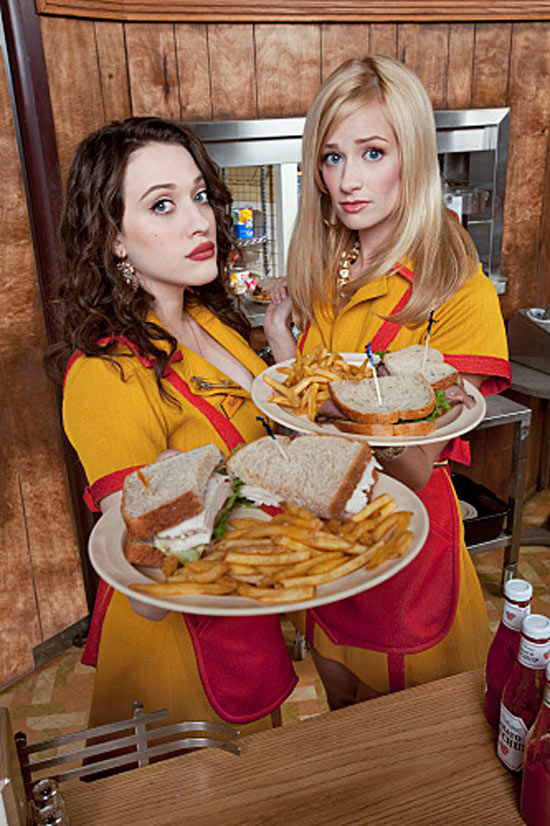 •
Getting staff is extremely difficult for
restaurants. The reasons are many,
not least that many waiters, busboys and
dishwashers are making as much or more from
unemployment benefits than the minimum wage they
might have been paid. They have the upper hand now
in hiring. At one noted New York restaurant, the
owner paid to have a former dishwasher fly from
the Dominican Republic to work at his place again
and at a higher salary. Everyone else on the staff
was new. Therefore, do not expect that your
favorite server is still there or that any of the
new ones have much training just yet.
•
Getting staff is extremely difficult for
restaurants. The reasons are many,
not least that many waiters, busboys and
dishwashers are making as much or more from
unemployment benefits than the minimum wage they
might have been paid. They have the upper hand now
in hiring. At one noted New York restaurant, the
owner paid to have a former dishwasher fly from
the Dominican Republic to work at his place again
and at a higher salary. Everyone else on the staff
was new. Therefore, do not expect that your
favorite server is still there or that any of the
new ones have much training just yet.
•
Expect abbreviated menus. With so many
restaurants still at less than 100% capacity (many
because
they cannot get sufficient staff), they have to
maximize their buying of food they know will sell
well. Special purchases can be an iffy proposition
if only three people order the sweetbreads that
the chef bought ten portions of. Your old
favorites will probably still be on the menu,
though.
•
Wine lists may offer bargains. During the pandemic
restaurateurs ordered next to no new wine, and
many sommeliers and beverage directors were laid
off and not re-hired as essential to running the
business. So, restaurants have to move the wines
that have been lying in their storage quickly,
especially white wines that do not age as do most
reds. This means there will be bargains galore. If
there is no longer a wine advisor, don’t blame the
new waiter for not knowing the distinction between
two Puligny-Montrachet Burgundies put on the list
five years ago.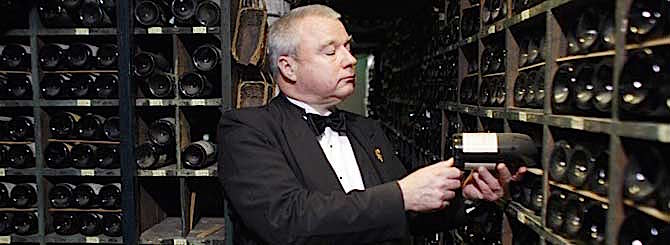
•
Amenities may be fewer. Those abundant
bread baskets with big slabs of butter may be
gone, largely because so much of it has, by law,
to be thrown away because of possible
contamination by someone at a table. Items like
fresh flowers, salt and pepper shakers (which,
sadly, get frequently stolen) and cloth napkins
and tablecloths (which is a big laundry expense)
may all be gone. The wine glasses may not be of
the quality they once were.
•
Expect prices to rise. Aside from the loss of income
restaurateurs endured for the past year, food
prices have gone inexorably up, not least beef,
which, believe it or not, is not a
high-profit item in a steakhouse charging $50 for
a ribeye. So, menu prices have to reflect those
increases; they’re not trying to gouge you.
 •
Tip at least what you did before. If 15% is still the reasonable
average for a tip at a good restaurant and 20% for
very good service, you might now consider 20%
(before taxes) as a generous but reasonable tip
for people who have been so long out of work. In
most major cities in America 20% has become pretty
much the average anyway.
•
Tip at least what you did before. If 15% is still the reasonable
average for a tip at a good restaurant and 20% for
very good service, you might now consider 20%
(before taxes) as a generous but reasonable tip
for people who have been so long out of work. In
most major cities in America 20% has become pretty
much the average anyway.
•
Don’t fuss about wearing a mask. I hate the masks. Everyone hates
the masks. And many of us who have the full
vaccinations
need not worry much about infections at a
dinner table. Still, because of conflicting
municipal requirements, guests still need to have
their temperature taken and to wear a mask, even
if only to traverse the ten feet from the host
desk to your table. And I’ve found that if you’ve
neglected to bring a mask, they have an ample
supply.
❖❖❖
202 Eighth Avenue
646-850-0764
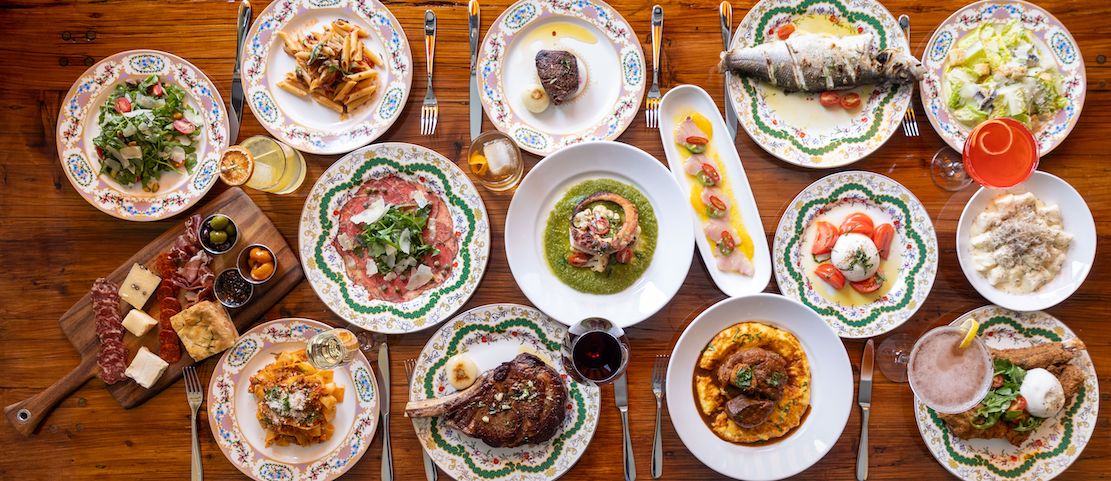
The provocative story of how spaghetti
alla puttanesca—a classic of Roman cookery
made with tomato, onions, capers and
anchovies—got its name as a quick dish made by
Roman harlots (puttante)
between turning tricks, seems wholly fanciful,
not least because it isn’t all that quick to
make. But if you seek one of the most authentic
and intense versions of it in New York, head for
the charming new trattoria in Chelsea that
shares its name.
Owners Bob and Enrico Malta and chef David
DiSalvo had a restaurant of the same name in
Hell’s Kitchen, now closed, and re-opened this
spring in a sunny 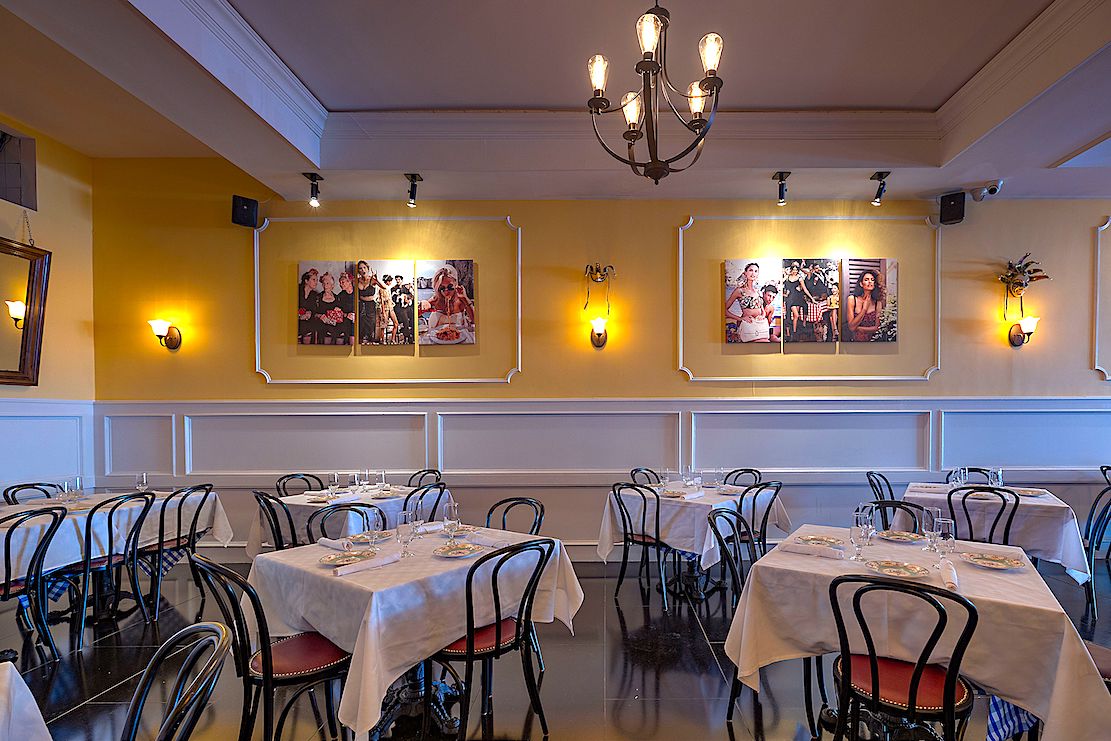 yellow room
with white wainscoting and high ceilings (which
can cause a high noise level) and an array of
seductive photos of beautiful Italian women
consuming pasta. Bentwood chairs, white
tablecloths and pretty votive candles make for a
refreshingly colorful, buoyant ambiance.
yellow room
with white wainscoting and high ceilings (which
can cause a high noise level) and an array of
seductive photos of beautiful Italian women
consuming pasta. Bentwood chairs, white
tablecloths and pretty votive candles make for a
refreshingly colorful, buoyant ambiance.
The ebullient DiSalvo is very proud of his
menu and bounds in and out of the kitchen to make
recommendations and serve dishes and, with a small
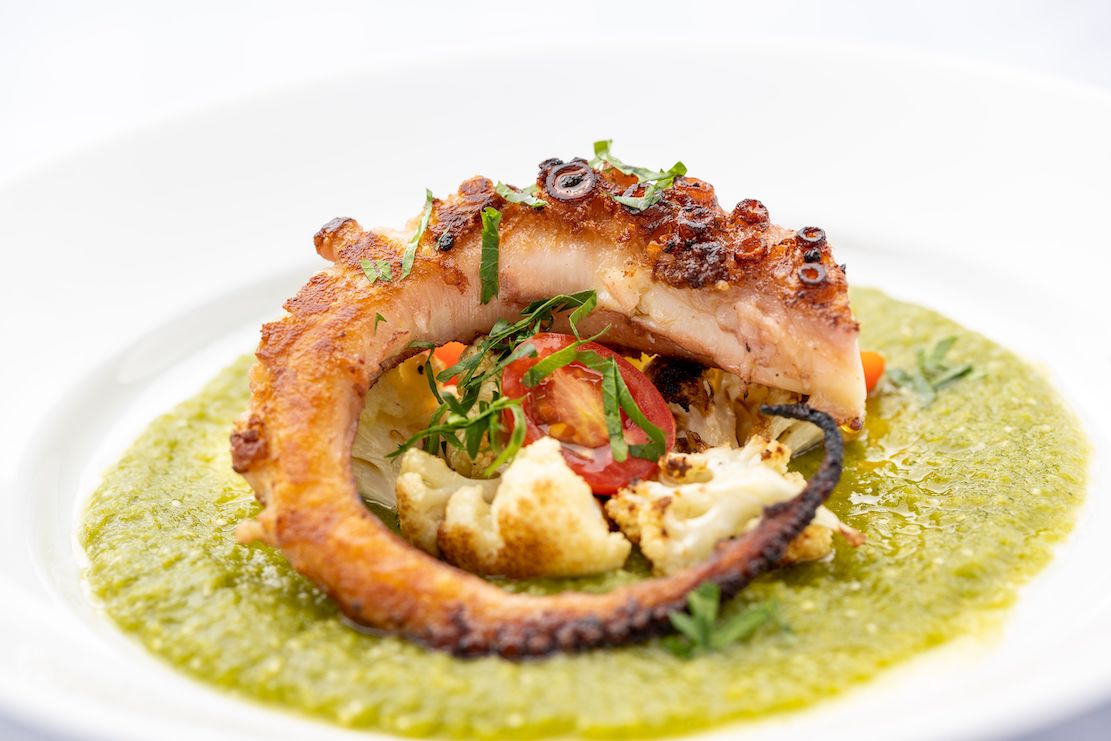 kitchen
crew, does so with a welcome cadence you find in
trattorias in Italy. (He must have a highly
organized mise-en-place.)
He’s got Sicilian roots via his family and cooks
with enormous gusto. Also, having attended the
Culinary Institute of America, then working at
Blaue Gans, Wällse and as executive chef at STK
Downtown, he knows how to handle crowds.
kitchen
crew, does so with a welcome cadence you find in
trattorias in Italy. (He must have a highly
organized mise-en-place.)
He’s got Sicilian roots via his family and cooks
with enormous gusto. Also, having attended the
Culinary Institute of America, then working at
Blaue Gans, Wällse and as executive chef at STK
Downtown, he knows how to handle crowds.
To begin, do not fail to order the puffy,
olive-oil and rosemary-rich focaccia
($6), whose aroma, yeastiness and a touch of
molasses makes it what I’ve found to be the best
in the city right now. There is
a selection of house-marinated olives ($6) and a
trio of cheeses with fig jam ($21) with which you
also get that wonderful focaccia
to share. There is also a raw bar including
yellowtail crudo
($19) and a seafood tower ($79).
Each of the
antipasti I tried had authority, not least an
abundant fritto
misto ($22) of peppery calamari, langoustine
and zucchini, cooked so that they are hot, crisp
and retain their individual flavors, to be dipped
into a spicy marinara and citrus aïoli. The
ricotta-stuffed eggplant involtini
($15) is sloppy in the most delightful way, the
ricotta creamy and the eggplant lusciously cuddled
by it. Tender
Spanish octopus (left) is dressed with a
lovely salsa
verde and cauliflower ($20)
Turning to the generous and well-priced
pastas, DiSalvo hit a bull’s eye with a puttanesca as
lusty as its legendary name ($15),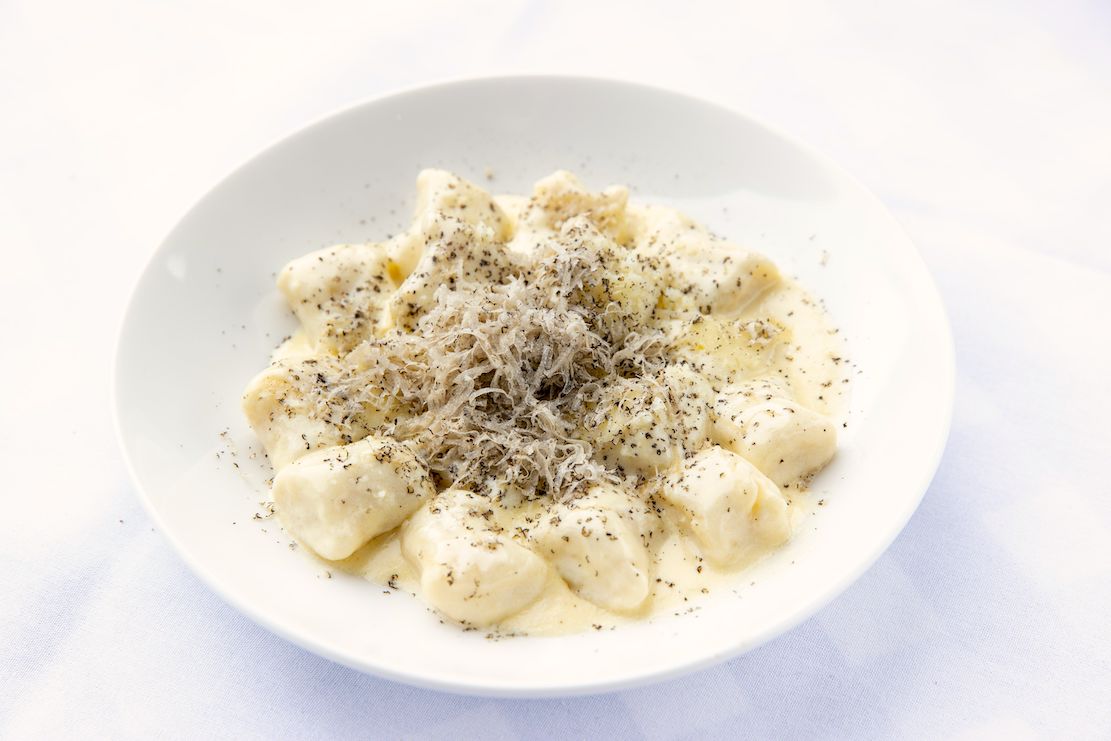 and, as with the involtini,
his Sicilian pasta alla Norma (so
called
because it was made to commemorate the opening of
Bellini’s opera Norma in
Palermo) was a fine tangle of rigatoni, eggplant,
tomato and ricotta
salata ($15). Linguine
alle vongole
($25), served cooked in the shells, was a fine
rendering of this classic, and potato gnocchi in a
cream sauce with summer truffles that, for once,
had some real flavor ($32), was a richly
satisfying dish (right).
and, as with the involtini,
his Sicilian pasta alla Norma (so
called
because it was made to commemorate the opening of
Bellini’s opera Norma in
Palermo) was a fine tangle of rigatoni, eggplant,
tomato and ricotta
salata ($15). Linguine
alle vongole
($25), served cooked in the shells, was a fine
rendering of this classic, and potato gnocchi in a
cream sauce with summer truffles that, for once,
had some real flavor ($32), was a richly
satisfying dish (right).
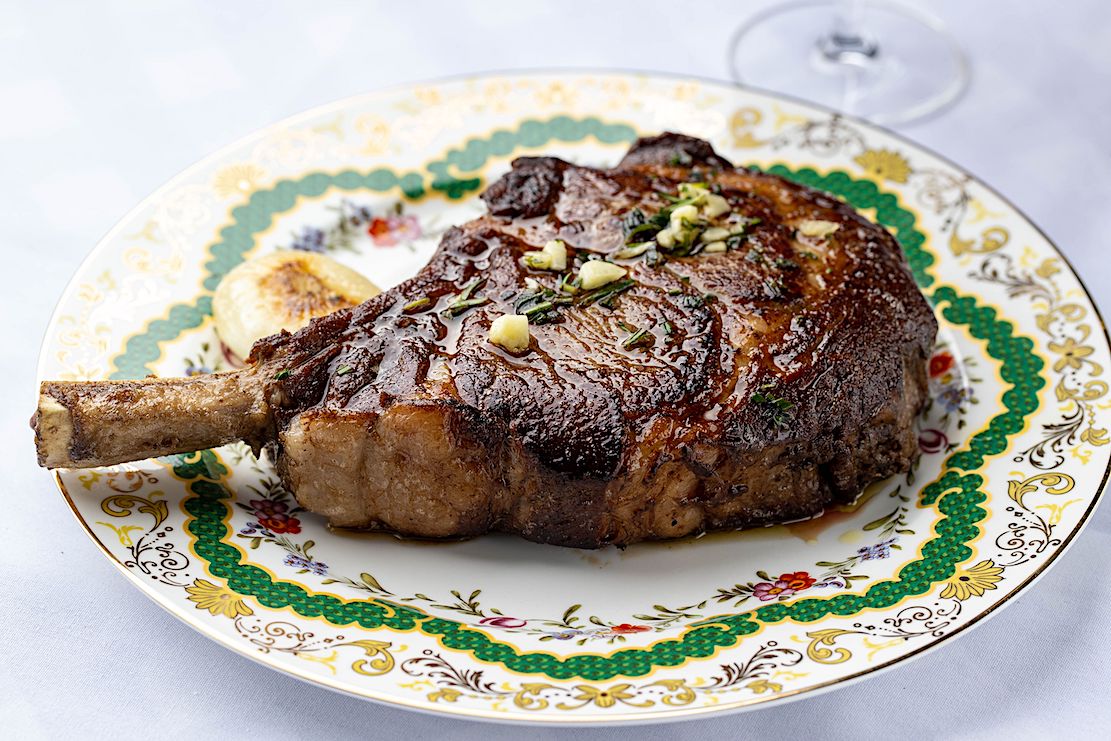 Under
the main courses, DiSalvo is rightly proud of his
bistecca di
manzo, a 45-day dry-aged Angus bone-in
ribeye of daunting proportions. Intended for two
at $99, it can serve three easily, and not only is
it perfectly cooked and of the same thickness you
will find in Florence restaurants, but the
minerality of the beef and the ideal searing make
this one of the best steaks I’ve had in New York,
better than those at a lot of steakhouses.
Under
the main courses, DiSalvo is rightly proud of his
bistecca di
manzo, a 45-day dry-aged Angus bone-in
ribeye of daunting proportions. Intended for two
at $99, it can serve three easily, and not only is
it perfectly cooked and of the same thickness you
will find in Florence restaurants, but the
minerality of the beef and the ideal searing make
this one of the best steaks I’ve had in New York,
better than those at a lot of steakhouses.
As noted, portions are large, and
the branzino
has got to be a two-pounder, juicy, adorned with
olive oil and lemon slices, and scented with
rosemary ($38), again readily a dish for two
people.
Everything is made in that kitchen
including fine cannoli ($5) and ice cream affogato,
with hot coffee poured over it and served with
biscotti ($9).
I’m hoping the wine list will get larger
and more interesting than it now is, and the
prices are high. A Santi Pinot Grigio 2019 that
sells for about $9 in the store shouldn’t be
selling for $54, nor should a $17 bottle of Dorigo
Sauvignon Blanc cost $60. Special cocktails are
more reasonable at $14-$16.
Eighth
Avenue is chockablock with restaurants of every
stripe, not least run-of-the-mill Italian, but for
its focus, its authenticity and attention to
timing, Puttanesca is distinguishing itself and
should soon be a destination for those who know
true trattoria cooking.
CAPONE’S
GOLD
As soon as she got to the airport in
Chicago, Katie called David, but got a
recording, so she boarded her flight and was
back at LaGuardia in two hours. There
she took a taxi to her apartment on Campbell
Drive, tossed her things on the bed and called
David again.
This time he answered.
“David, it’s me.”
“Hey, how’d it go with the Capone house? The
letter from Cunningham work?”
“Like a charm. The owner, a Mrs. Farrell,
let me right in.”
David pretty much knew the answer to his
next question but asked, “So, what’d you find?”
“Frankly, nothing. The
place has been re-done over the years but I
couldn’t find anything like a secret room inside
or in the garage. But you know what surprised me?”
“What?”
“How it wasn’t
much of a house. I mean, he was one of the richest
men in the world and he lived with his wife and
mother in a three-story brick building. A
mansion it is not.”
“That sounds about right,” said David.
“Those guys, even today, liked to live well but
not ostentatiously, because it would draw
attention from the cops and the feds. Also,
the smaller the house, the easier to secure and
the more difficult for their enemies to sneak in. Security
is much better when it doesn’t have to cover huge
areas.”
“Well, that makes sense,” said Katie.
“Anything else?”
“Yeah, kind of a coup! Your friend
Cunningham located Capone’s psychic I told you
about, Alice Britt.
She’s still alive, in a nursing home
outside of Chicago, and I actually visited her and
interviewed her.”
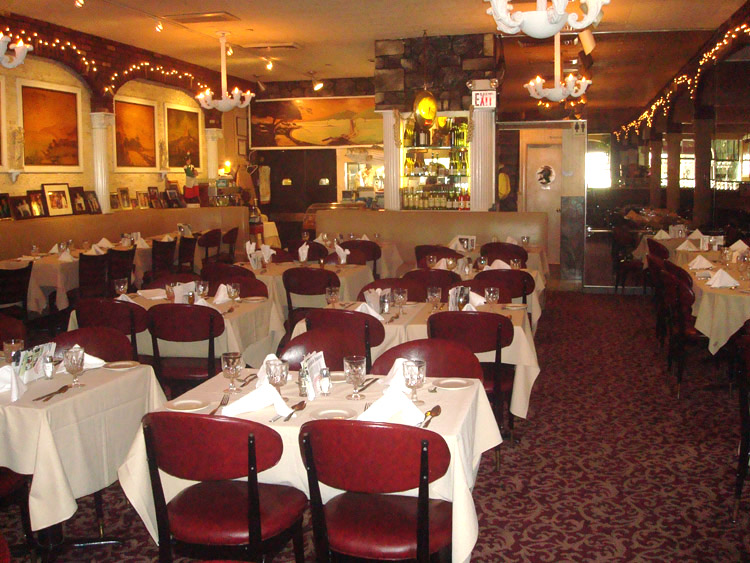 “She’s still got all her marbles? She’s
gotta be pretty old.”
“She’s still got all her marbles? She’s
gotta be pretty old.”
“Almost ninety,” said Katie. “She’s frail
but her mind’s as sharp as a tack. She told me
Capone was very scared of dying.”
“Who isn’t?”
“Okay, but she was hired because Al was
seeing ghosts and raving. Listen,
I’ll fill you all in when I see you. How
about you coming down here? I don’t
want to use up more expense account money on
motels. And I’ll take you for the best pizza in
New York.”
“How can I turn that down?”
“Good, it’s Mario’s (left), on
Arthur Avenue,” said Katie, then, “Oh, one kind of
odd thing happened when I visited the Capone
house.”
“What?”
“Well, I was only in there for about
fifteen, twenty minutes, but when I came out I saw
a car with a man in it that had been parked there
when I went inside.
He had a camera with him, perched on the
car door. I didn’t think anything about it until
my taxi was driving away and the driver waves at
the guy in the car and tells me he knows the guy
and that he’s a cop. What do you make of that? Anything?”
“Hmm,” murmured David. “I don’t know.
Probably nothing, maybe the guy lives in the
neighborhood.
Anyway, it’ll take me about an hour to get
down there. Meet
you at the restaurant?”
“Fine.
Bring an appetite.”
*
*
*
*
David
was already sitting on a banquette at Mario’s when
Katie walked through the door, where she was
immediately greeted by the owner, Joe Miglucci,
who said he hadn’t seen her for a while. Katie
then introduced him to David, who said, “Katie
tells me you make the best pizza in New York. And I
was born in the Bronx.”
“Katie knows her pizza,” said Joe proudly.
“What can I start you off with?”
Katie ordered a Campari and soda, David an
Absolut on the rocks.
“I never understand people who drink
straight vodka on the rocks,” said Katie. “It
doesn’t have any taste at all.”
David shrugged and said, “We’ll have a nice
bottle of wine afterwards. So, Katie, before we
get into your hair-raising adventures—I’m
kidding—how about telling me more about Katie
Cavuto?”
“You know most of it. Where I grew up, who
my parents are, what I do, what I want to do.”
“Yeah, but where’d you go to school, what’d
you major in, how’s your love life, that sort of
thing.”
Katie feigned being shocked, saying, “First
things first. I went to Villa Maria Academy (right)
near where I live now, for grammar school.”
“Nuns?”
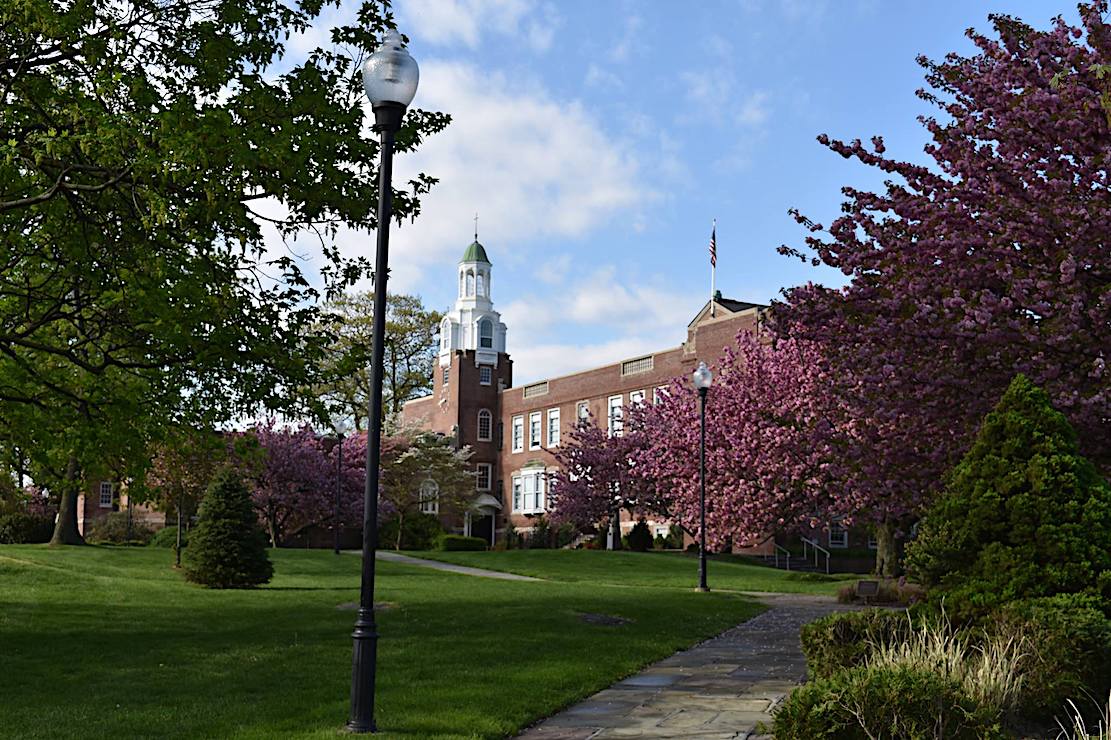 “Yes,
Sisters of Notre Dame of Montreal. Stern,
but they had French roots, so they were also
snooty. They
taught us French in first grade. Or tried
to.”
“Yes,
Sisters of Notre Dame of Montreal. Stern,
but they had French roots, so they were also
snooty. They
taught us French in first grade. Or tried
to.”
“I had nuns in parochial school,” said
David. “Saint
Helena’s near Castle Hill. They
were tough women.
I wasn’t their best pupil. I’ll bet
you were.”
“I was a pretty good student. With my
parents and sister I had a lot to compete with. So
then I went to Ursuline Academy in New Rochelle.”
(Left)
“All these academies,” said David. “I never
knew what the difference was.”
“They were just names for private Catholic
schools. The girls went to academies, the boys
went to prep schools; the schools attached to
parish churches were called parochial.”
“But New Rochelle’s in Westchester County. You
didn’t move up there?”
“No. My father would drive me up in the
morning—it was only ten minutes away from where we
lived in the Bronx.
Just hop on the Hutchinson River Parkway
and you’re there.
Then a schoolmate’s mother would drive us
home in the afternoon. It
worked out fine.”
“Well, now that you mention it,” said
David, “I did go to a private boy’s high school,
Cardinal Hayes. But they sure didn’t 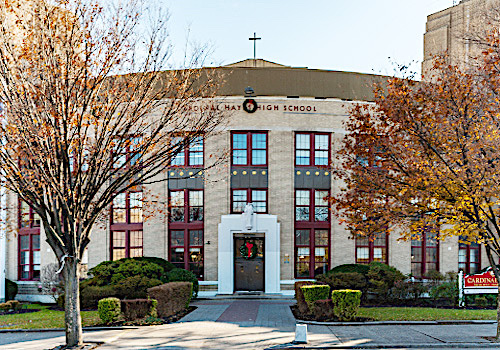 call it a prep school.”
call it a prep school.”
“On the Grand Concourse. Sure. I know
Hayes. South Bronx. You look like you played
football.”
“I did.
I wasn’t the biggest kid on the team but I
was fast and had good hands. Played tight end.”
“Was that a rough neighborhood then?” asked
Katie, pretty much knowing the answer.
“It was getting pretty tough in those days.
Which is why I guess your parents sent you out of
the borough.”
Katie sipped her drink. “Where we lived was
fine, but my parents didn’t like any of the
Catholic high schools in the Bronx, so I ended up
at Ursuline.”
“Academy.”
“Yes, Academy.”
“Then what college?”
“Fordham ( below), majored in
History,” she said.
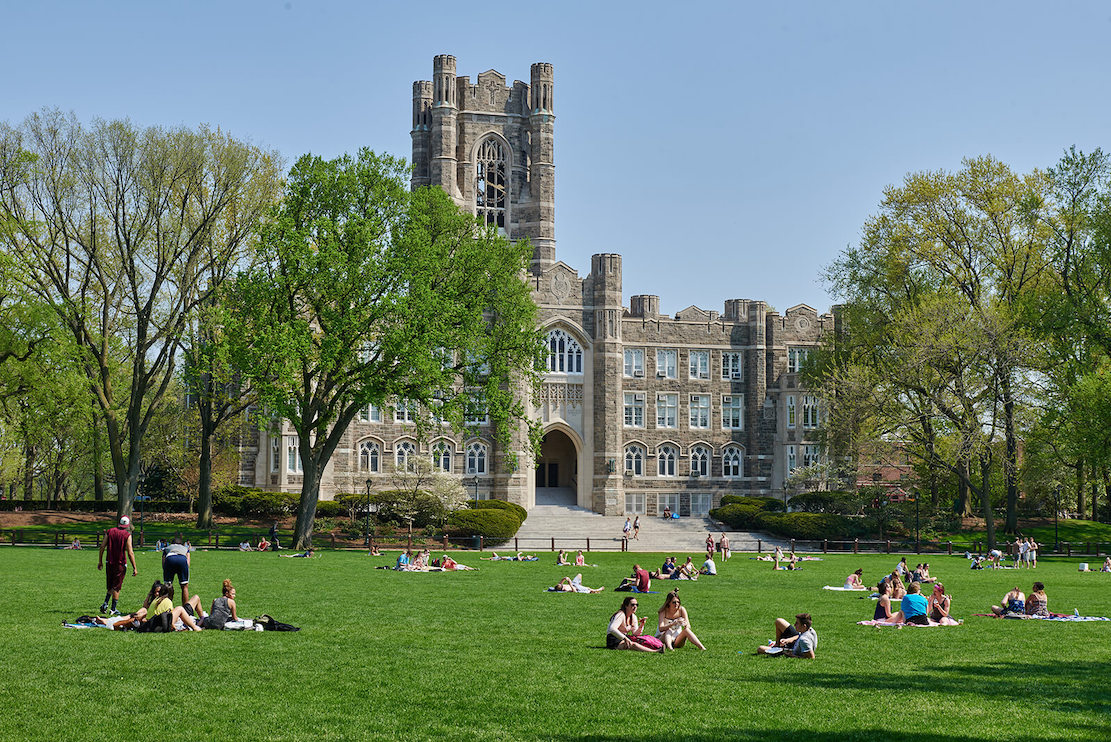 “That’s obvious from your research,” said
David, who finished his drink and asked the waiter
for the wine list.
“That’s obvious from your research,” said
David, who finished his drink and asked the waiter
for the wine list.
“Then I found out I liked writing and I got
a job with the Bronx News.”
“So now we’re up to your love life.”
“Not so fast,” Katie laughed. “Let’s
order dinner.
But first we have to have one of the
pizzas. You’ll
be impressed.”
David admitted he was. “There’s
some contenders in Brooklyn,” he said, as the
waiter poured a bottle of Barbera, “but this is
damn good pizza.
Great crust.
Not to change the subject yet again, but,
seriously, Katie, you been married?”
Katie took a sip of wine and said, “That’s
delicious wine.”
“Katie?”
“No, never been married, much to my
family’s disappointment. Not that
I’m against it.
I got close once, engaged to a lawyer, but
looking back I’m pretty sure that was to make my
father happy.
Nothing all that serious since then.”
“Okay,” said David. “Fair enough.”
“And what about you? You look like the
marrying kind.”
“I was,” he said. “To a wonderful woman I
loved very much. But, I’m sorry to say, she passed
away before we had a chance to have children.”
“Oh, I’m so sorry,” said Katie, wanting to
know but not wanting to ask how it happened,
sensing that David had learned to cook after he lost his wife.
to cook after he lost his wife.
“She was a flight attendant,” said David,
staring at his wine, then at the wall. “And in one
of those freak accidents, her plane crashed coming
into LaGuardia, and, well, she didn’t make it out. Everybody
else
got out because she was there to help them. But she
got engulfed by the smoke. It was
her last flight before she was to have three weeks
off and I had three weeks off. It was going to be
our first real vacation since we got married. ”
“She sounds like a remarkable woman,” said
Katie.
“That she was,” said David, smiling and now
looking at Katie again.
“Then let’s drink to her,” she said.
“Yeah, let’s do that.” David and Katie held
up their glasses. “Here’s to Sharon. Best
wife any man ever had.”
With that it was clear to both
of them that they’d better start eating while
talking about the Capone project. The
waiter brought David an order of pasta with
eggplant and tomato and Katie veal francese.
“I’ve been thinking about what you told me
about the cop in the car,” said David. “It does
sound a little odd.
Driving down here I thought, well, yeah, he
lives in the neighborhood or he could be on a
stake-out, not at Capone’s house but for something
else. Which
is why he’d have a camera with him. Or maybe
he just thought you’re a good-looking woman, which
you are.”
“Thank you.”
“But it kept
bothering me that it’s a little too coincidental
that a Chicago cop was there just as you got
there,” said David. “Then I thought maybe my
friend Cunningham sent him out there to make sure
you got into the house. Was the
guy in uniform?”
“No, from what I could see he just had on a
short sleeve shirt.”
“Did you get his name?”
“Yeah, I asked the cabbie and I wrote it
down. Here
it is: Frascella.
He didn’t know his first name.”
“Okay,” said David, “tomorrow I’m going to
check him out with Cunningham. Like I said, it’s
probably nothing but it’s worth a phone call.
How’s your veal?”
“Perfect! Your pasta?”
“Fantastic. So, let’s put our heads
together here and see what we’ve got—if anything
more than some Chicago social history. Did you
bring your research?”
“Yes,” she said, “but let’s finish this
delicious meal before I start taking out folders.” She
looked piqued by the crack about “Chicago social
history.”
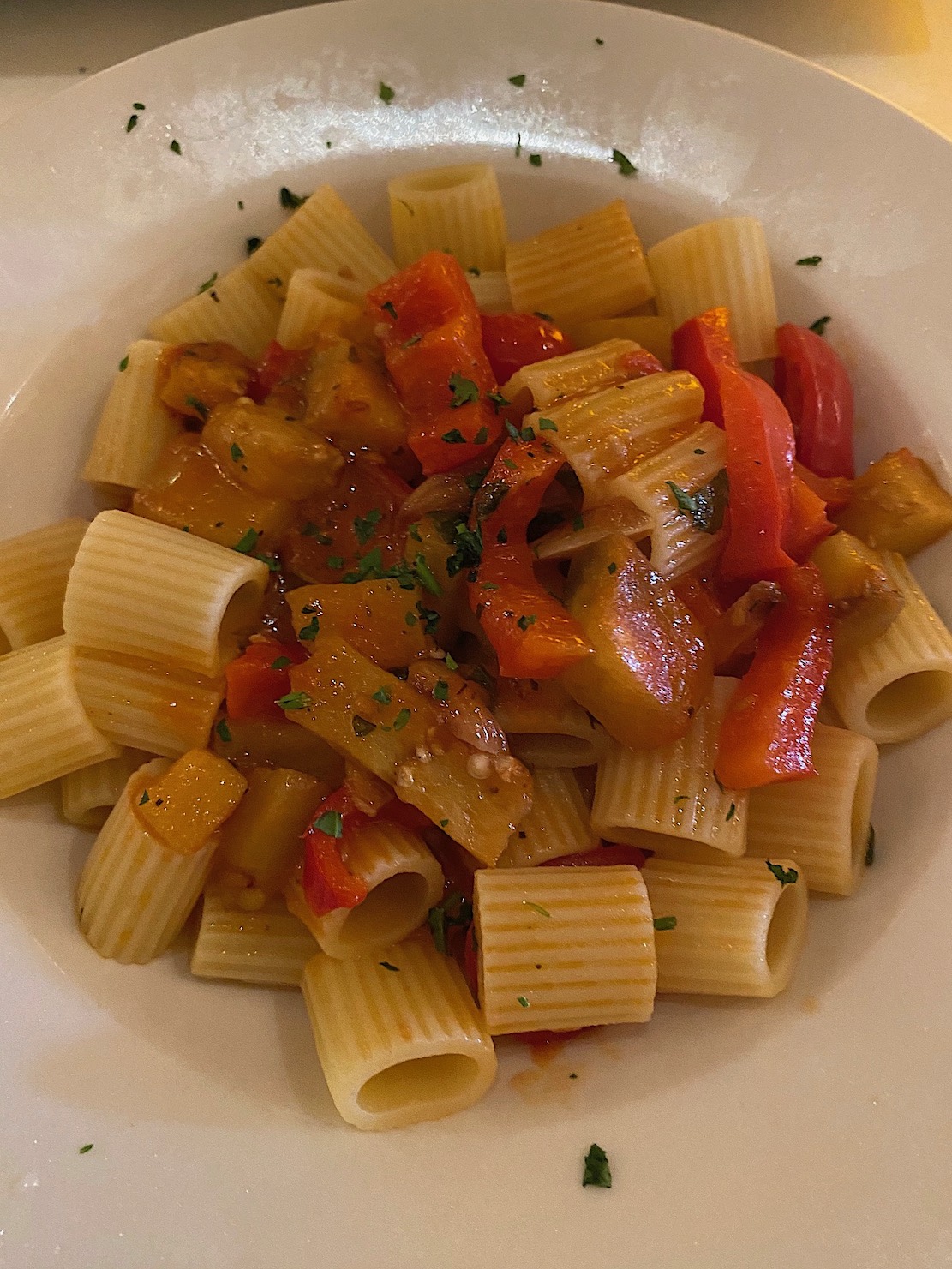 “Okay,” said David, after their plates were
cleared from the table. “So, so far we know that
Capone held up the armored truck with a dozen or
so men, blindfolded the guards, loaded the bullion
in more or less equal amounts into three trucks.
“Okay,” said David, after their plates were
cleared from the table. “So, so far we know that
Capone held up the armored truck with a dozen or
so men, blindfolded the guards, loaded the bullion
in more or less equal amounts into three trucks.
“And they each headed off in a different
direction. So they didn’t meet up somewhere else.”
“According to my source, no,” Katie said.
“Because he headed west and stopped to switch to a
car while other guys he didn’t know took the
truck.”
“How’d he know those other guys were
Capone’s men?” David asked Katie.
“I guess he didn’t, but that was the plan
from the start.”
“So, isn’t it possible that those new
drivers all later met at a central location in
which the gold would be unloaded and hidden?”
David wondered.
“My source said probably not, because at
one location they would be at greater risk of
getting picked up by the feds. Remember,
the
feds didn’t know it was three trucks they were
after. It
could have been one or six. The more roadway three
trucks put between them and the feds by going in
different directions, the more they cut down on
the chances of them all being caught. And,
even if the feds got lucky and nabbed one truck,
they only would have gotten one-third of the gold
while the other two-thirds was already far away.”
“But what if they did get one of the trucks
and got the driver to talk?” David asked.
“Highly unlikely the drivers would
talk—they knew the routine and what would happen
to them if they did.
But it was even more unlikely they knew
anything at all about the grand scheme, not even
if there were other trucks or who the first
drivers were. And by then the gold would have been
safely under lock and key in three different
places.”
“Pretty ingenious all around,” David had to
admit.
“So all criminals are not so stupid then,
as you once told me?”
“You only need one semi-smart one to come
up with the plan,” he answered. “Everyone
else just did what he was told. You
always want the smallest number of people to know
about any detail.
And, remember, Capone had been planning
this for more than two years.”
The evening ended late, with coffee and a
shared piece of cheesecake.
“Listen,” said Katie, “You think you should
drive home after the vodka and the wine?”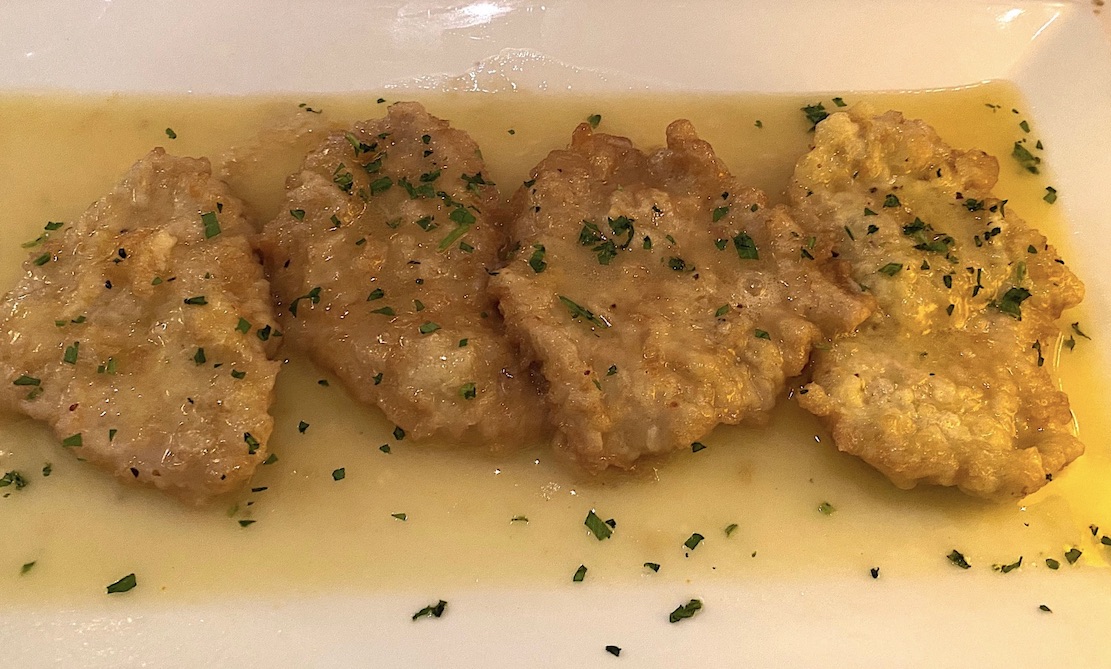
“I’m fine,” said David.
“Because if you want to spend the night at
my apartment, there’s an extra bedroom.”
David would have liked that but said, “No,
I’m fine to drive. But let’s flip a coin to see
whose place we meet at tomorrow.”
“Y’know, you’re really a stubborn guy,”
said Katie. “Spend the night at my place and we
get an early start going over what we do next.”
David was tired. The
drive down, the vodka, the wine, the food, the
espresso with a shot of sambuca.
“You sure it’s no trouble?” he asked.
“I don’t make great eggs, but you won’t
starve.”
“All right, it’s not a bad idea,” he said,
trying to sound like it was all her decision.
They drove their separate cars back to
Katie’s place—ten minutes away. Once in her
apartment Katie got out some towels and gave David
a new toothbrush.
David thought, she’s probably done this
before, then put it out of his mind.
“So, see you bright and early,” she said.
“I’m up about six-thirty. Old
habits.”
“Fine, there’s a coffeemaker on the
counter. Wake
me at seven-thirty.”
As it turned out,
Katie shook David awake at eight.
❖❖❖
By Geoff Kalish
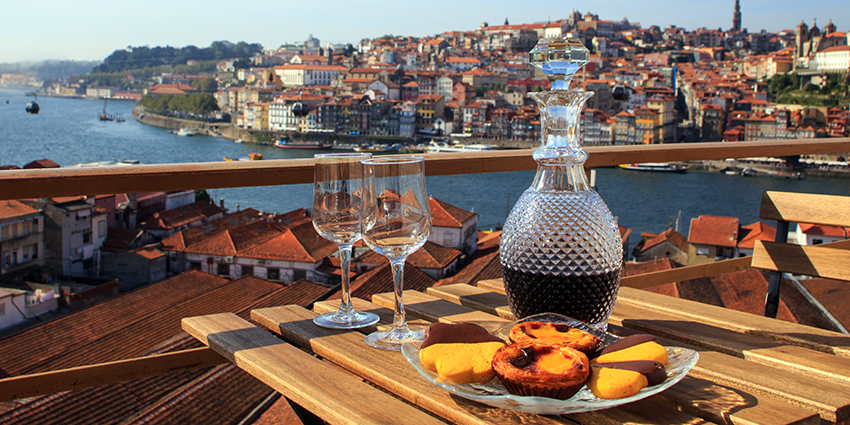
 Herdade de Sao
Miguel Colheita Seleccionada Rosé 2020
($7)—Made from a blend of Touriga Nacional,
Aragonez and Syrah grapes, this dry rosé shows a
very pale pink color, a bouquet of watermelon and
lime and a taste of apples and citrus with a crisp
finish perfect to pair with sushi or a range of
appetizers, like smoked salmon, bruschetta or
toast with olive tapenade.
Herdade de Sao
Miguel Colheita Seleccionada Rosé 2020
($7)—Made from a blend of Touriga Nacional,
Aragonez and Syrah grapes, this dry rosé shows a
very pale pink color, a bouquet of watermelon and
lime and a taste of apples and citrus with a crisp
finish perfect to pair with sushi or a range of
appetizers, like smoked salmon, bruschetta or
toast with olive tapenade. Caves de Cerca Famega Vinho Verde 2019 ($8)—This light, fruity low-alcohol white was made from a blend of indigenous grapes from the Minho area in northern Portugal. It shows a bouquet and taste of green apples and lime with citrus in its finish. It mates well with shrimp, scallops, lobster or sushi.
Herdade Do Esperao Monte Velho Blanco 2019 ($10)—Produced sustainably in the Alentejo by the Roquette family from a blend of organically grown indigenous grapes (Antas Vaz, Roupeiro and Perrum varietals) this white shows a bouquet and taste of well-integrated flavors of apple, peach, lemon and grapefruit with a long lingering finish. Marry it with shrimp scampi, chicken or pasta primavera.
Casa Santos Lima Lab 2017 ($8)—This very popular red is made from a blend of Castelao, Tinta Roriz, Syrah and Touriga Nacional grapes grown just outside Lisbon. It shows a bouquet and smooth taste of plums and cherries. Serve it with hamburgers, pizza, pasta with red sauce or even grilled skirt steak.
Cartuxa Eugenia de Almedia EA Tinto 2018 ($8)—This blend (35% Aragonex, 30% Tricandeira, 20% Alicante Bouschet and 15% Syrah) is a light, fruity red with a bouquet and easy-drinking flavor of plums, cherries and notes of chocolate in its smooth finish. It mates well with a wide range of fare from chicken to veal to pork chops.
Herade da Esporaro Monte Velho Tinto 2019 ($8)—This red blend (Aragonez, Trincadeira, Touriga Nacional and Syrah) is far more elegant than its price would indicate and shows a bouquet and rich taste of plums, cassis and cherries that marries harmoniously with salmon, Arctic char or veal.
Carmim Monsaraz Reserva 2018 ($8)—Made from a blend of grapes (Alicante Bouschet, Trincadeira and
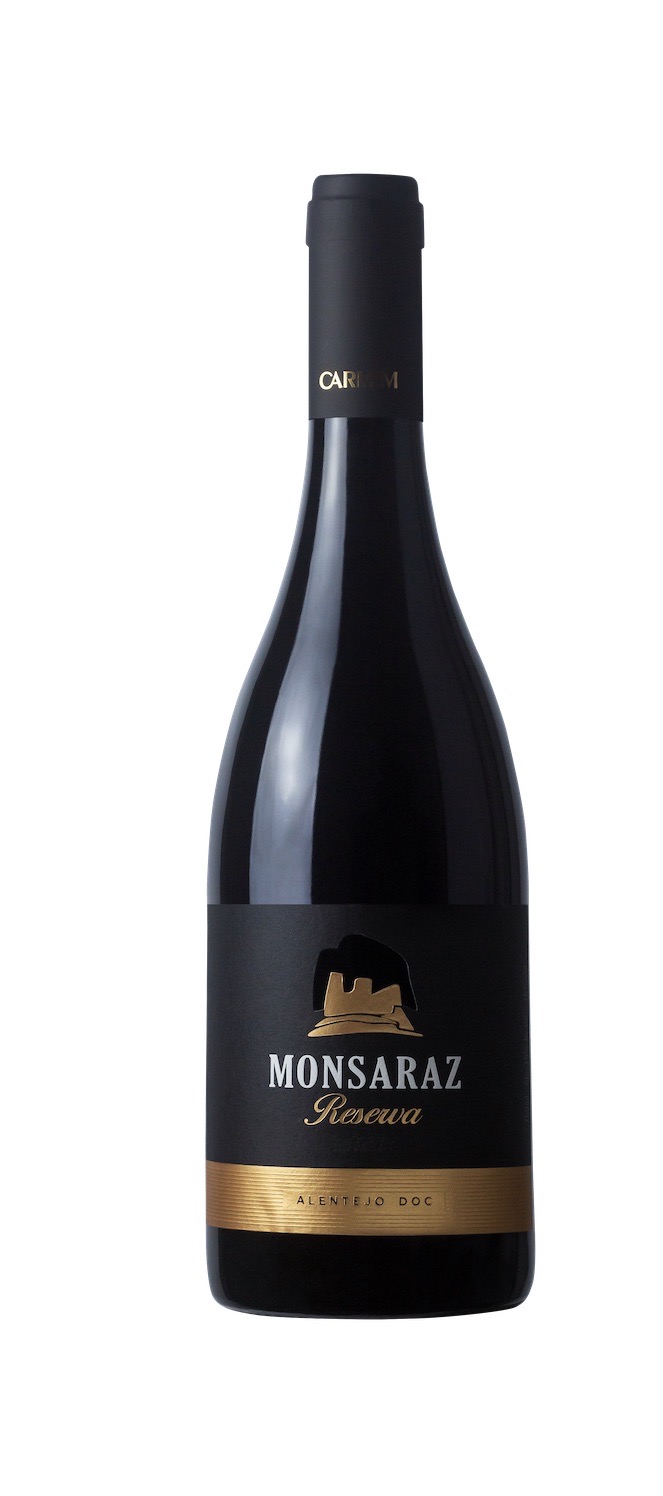 Touriga
Nacional), grown in the Alentajo region, this
robust wine was aged in a combination of French
and American oak for 9 months following
fermentation. It has a bouquet and taste of ripe
plums and blueberries and a mildly tannic finish.
Currently it makes good accompaniment to
steak and lamb and should become mellower with a
few years of bottle age and match a greater
variety of fare.
Touriga
Nacional), grown in the Alentajo region, this
robust wine was aged in a combination of French
and American oak for 9 months following
fermentation. It has a bouquet and taste of ripe
plums and blueberries and a mildly tannic finish.
Currently it makes good accompaniment to
steak and lamb and should become mellower with a
few years of bottle age and match a greater
variety of fare.Bacalhoa Quinta do Carmo Tinto 2018 ($10)—Fashioned from a blend of indigenous grape varietals plus Syrah and Cabernet Sauvignon, this red shows a bouquet and taste of cassis and plums that pairs well with grilled lamb or veal. Of note, the 1993 version (from my cellar) still had plenty of oomph with a taste of cassis and crushed violets that matched well with grilled porterhouse and dark-veined cheeses.
Aluado Reserva 2019 ($14)—This 100% Alicante Bouschet red from the winemaker Jose Neim Correio hails from the Lisboa area along the Atlantic Coast. It has a bouquet and taste of plums, cherries and cassis with a touch of vanilla in its dry finish that matches the taste of turkey, duck or veal quite well.
Herdade do Rocim Amphora Tinto 2019 ($16)—This blend of several native grape varietals, grown in the southern portion of the Alentejo region, was fermented and aged in clay amphora using indigenous yeast and without any temperature control. It shows a bouquet and medium-bodied taste of cherries, blueberries and cassis with a finish dominated by a taste of earthy herbs and peppers that dissipates with some decanting. It makes good accompaniment for veal, chicken or mild cheeses.
 HOW TO GET A
BUZZ ON. . . FAST!
HOW TO GET A
BUZZ ON. . . FAST!Despite
saying that he “hates honey” and is “deathly afraid of
bees,” YouTube personality L.A. Beast, a "competitive
eater," drank an entire gallon of honey, while his head
was covered in bees. The feat was made into a video .
❖❖❖
Sponsored by

Any of John Mariani's books below may be ordered from amazon.com.
 The Hound in Heaven
(21st Century Lion Books) is a novella, and
for anyone who loves dogs, Christmas, romance,
inspiration, even the supernatural, I hope you'll find
this to be a treasured favorite. The story
concerns how, after a New England teacher, his wife and
their two daughters adopt a stray puppy found in their
barn in northern Maine, their lives seem full of promise.
But when tragedy strikes, their wonderful dog Lazarus and
the spirit of Christmas are the only things that may bring
his master back from the edge of despair.
The Hound in Heaven
(21st Century Lion Books) is a novella, and
for anyone who loves dogs, Christmas, romance,
inspiration, even the supernatural, I hope you'll find
this to be a treasured favorite. The story
concerns how, after a New England teacher, his wife and
their two daughters adopt a stray puppy found in their
barn in northern Maine, their lives seem full of promise.
But when tragedy strikes, their wonderful dog Lazarus and
the spirit of Christmas are the only things that may bring
his master back from the edge of despair. WATCH THE VIDEO!
“What a huge surprise turn this story took! I was completely stunned! I truly enjoyed this book and its message.” – Actress Ali MacGraw
“He had me at Page One. The amount of heart, human insight, soul searching, and deft literary strength that John Mariani pours into this airtight novella is vertigo-inducing. Perhaps ‘wow’ would be the best comment.” – James Dalessandro, author of Bohemian Heart and 1906.
“John Mariani’s Hound in Heaven starts with a well-painted portrayal of an American family, along with the requisite dog. A surprise event flips the action of the novel and captures us for a voyage leading to a hopeful and heart-warming message. A page turning, one sitting read, it’s the perfect antidote for the winter and promotion of holiday celebration.” – Ann Pearlman, author of The Christmas Cookie Club and A Gift for my Sister.
“John Mariani’s concise, achingly beautiful novella pulls a literary rabbit out of a hat – a mash-up of the cosmic and the intimate, the tragic and the heart-warming – a Christmas tale for all ages, and all faiths. Read it to your children, read it to yourself… but read it. Early and often. Highly recommended.” – Jay Bonansinga, New York Times bestselling author of Pinkerton’s War, The Sinking of The Eastland, and The Walking Dead: The Road To Woodbury.
“Amazing things happen when you open your heart to an animal. The Hound in Heaven delivers a powerful story of healing that is forged in the spiritual relationship between a man and his best friend. The book brings a message of hope that can enrich our images of family, love, and loss.” – Dr. Barbara Royal, author of The Royal Treatment.
 |
The Encyclopedia of American Food and Drink by John F. Mariani (Bloomsbury USA, $35) Modesty forbids me to praise my own new book, but let me proudly say that it is an extensive revision of the 4th edition that appeared more than a decade ago, before locavores, molecular cuisine, modernist cuisine, the Food Network and so much more, now included. Word origins have been completely updated, as have per capita consumption and production stats. Most important, for the first time since publication in the 1980s, the book includes more than 100 biographies of Americans who have changed the way we cook, eat and drink -- from Fannie Farmer and Julia Child to Robert Mondavi and Thomas Keller. "This book is amazing! It has entries for everything from `abalone' to `zwieback,' plus more than 500 recipes for classic American dishes and drinks."--Devra First, The Boston Globe. "Much needed in any kitchen library."--Bon Appetit. |
"Eating Italian will never be the same after reading John Mariani's entertaining and savory gastronomical history of the cuisine of Italy and how it won over appetites worldwide. . . . This book is such a tasteful narrative that it will literally make you hungry for Italian food and arouse your appetite for gastronomical history."--Don Oldenburg, USA Today. "Italian
restaurants--some good, some glitzy--far
outnumber their French rivals. Many of
these establishments are zestfully described
in How Italian Food Conquered the World, an
entertaining and fact-filled chronicle by
food-and-wine correspondent John F.
Mariani."--Aram Bakshian Jr., Wall Street
Journal.
"Equal parts
history, sociology, gastronomy, and just
plain fun, How Italian Food Conquered the
World tells the captivating and delicious
story of the (let's face it) everybody's
favorite cuisine with clarity, verve and
more than one surprise."--Colman Andrews,
editorial director of The Daily
Meal.com. "A fantastic and fascinating
read, covering everything from the influence
of Venice's spice trade to the impact of
Italian immigrants in America and the
evolution of alta cucina. This book will
serve as a terrific resource to anyone
interested in the real story of Italian
food."--Mary Ann Esposito, host of PBS-TV's
Ciao
Italia. "John Mariani has written the
definitive history of how Italians won their
way into our hearts, minds, and
stomachs. It's a story of pleasure over
pomp and taste over technique."--Danny Meyer,
owner of NYC restaurants Union Square
Cafe, The Modern, and Maialino.
|
 |
 |
 |
 |
 |
 |
 Everett Potter's Travel Report:
Everett Potter's Travel Report: 
 Eating Las
Vegas JOHN CURTAS has been covering
the Las Vegas food and restaurant scene
since 1995. He is the co-author of EATING LAS
VEGAS – The 50 Essential Restaurants (as
well as the author of the Eating Las
Vegas web site: www.eatinglasvegas.
He can also be seen every Friday morning as
the “resident foodie” for Wake Up With the
Wagners on KSNV TV (NBC) Channel 3 in
Las Vegas.
Eating Las
Vegas JOHN CURTAS has been covering
the Las Vegas food and restaurant scene
since 1995. He is the co-author of EATING LAS
VEGAS – The 50 Essential Restaurants (as
well as the author of the Eating Las
Vegas web site: www.eatinglasvegas.
He can also be seen every Friday morning as
the “resident foodie” for Wake Up With the
Wagners on KSNV TV (NBC) Channel 3 in
Las Vegas.
MARIANI'S VIRTUAL GOURMET
NEWSLETTER is published weekly. Publisher: John Mariani. Editor: Walter Bagley. Contributing Writers: Christopher Mariani,
Robert Mariani, Misha Mariani, John A. Curtas, Gerry Dawes, Geoff Kalish,
and Brian Freedman. Contributing
Photographer: Galina Dargery. Technical
Advisor: Gerry
McLoughlin.
If you wish to subscribe to this
newsletter, please click here: http://www.johnmariani.com/subscribe/index.html
© copyright John Mariani 2021

